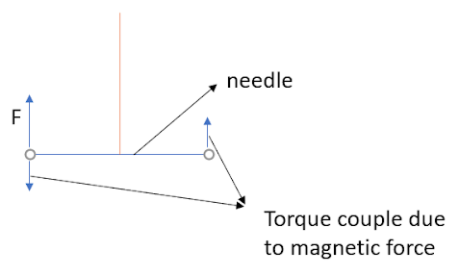
At some location on earth the horizontal components of earth’s magnetic field is $18\times {{10}^{-6}}T$. At this location, the magnetic needle of length 0.12 m and pole strength 1.8 Am is suspended from its middle point using a thread, it makes ${{45}^{o}}$ angle with horizontal in equilibrium. To keep this needle horizontal, the vertical force that should be applied to one of its ends is:
A. $3.6\times {{10}^{-5}}N$
B. $6.5\times {{10}^{-5}}N$
C. $1.3\times {{10}^{-5}}N$
D. $1.8\times {{10}^{-5}}N$
Answer
572.1k+ views
Hint: The mass of the needle will not play a part as the string is in the middle and it gets balanced. We will just have to consider the forces due to the magnetic field. We are given the horizontal component and the angle of the needle in equilibrium due to the magnetic field. The vertical force will counter the torque produced on the needle due to the magnetic force.
Formula used:
$\tau =M\times B$
Complete answer:
First, we will find the magnitude of the vertical component of the magnetic field of earth at that point. As we are given that the needle makes an angle of ${{45}^{o}}$ with the horizontal, then the magnitude of both the horizontal and vertical force on the needle due to the magnetic field of earth must be the same. So, the magnitude of the horizontal component of the magnetic field and the vertical component of the magnetic field of earth at this point must be the same. Thus, there is a magnetic field of magnitude in the vertical direction too.

Torque on the magnet due to the magnetic field will be given by
$\tau =M\times B$
Where M is the magnetic moment given as the product of the pole strength and the length of the magnet, needle in this case. We can directly take the product as the
$\tau =M\times B=18\times {{10}^{-6}}\times 1.8\times 0.12=3.89\times {{10}^{-6}}$
This will need to be balanced by the torque presented due to the force. The torque by the force will be
$\tau =F\dfrac{l}{2}$
When we equate both we get
\[F=\dfrac{2\times 3.89\times {{10}^{-6}}}{l}=\dfrac{2\times 3.89\times {{10}^{-6}}}{0.12}=6.5\times {{10}^{-5}}\]N
Hence, the correct answer is B, i.e. $6.5\times {{10}^{-5}}N$.
Note:
Students must take care that the torque due to the magnetic field is being calculated when the needle becomes horizontal, not when the needle is at an angle with the horizontal. Because that is when we will need to balance the forces.
Formula used:
$\tau =M\times B$
Complete answer:
First, we will find the magnitude of the vertical component of the magnetic field of earth at that point. As we are given that the needle makes an angle of ${{45}^{o}}$ with the horizontal, then the magnitude of both the horizontal and vertical force on the needle due to the magnetic field of earth must be the same. So, the magnitude of the horizontal component of the magnetic field and the vertical component of the magnetic field of earth at this point must be the same. Thus, there is a magnetic field of magnitude in the vertical direction too.

Torque on the magnet due to the magnetic field will be given by
$\tau =M\times B$
Where M is the magnetic moment given as the product of the pole strength and the length of the magnet, needle in this case. We can directly take the product as the
$\tau =M\times B=18\times {{10}^{-6}}\times 1.8\times 0.12=3.89\times {{10}^{-6}}$
This will need to be balanced by the torque presented due to the force. The torque by the force will be
$\tau =F\dfrac{l}{2}$
When we equate both we get
\[F=\dfrac{2\times 3.89\times {{10}^{-6}}}{l}=\dfrac{2\times 3.89\times {{10}^{-6}}}{0.12}=6.5\times {{10}^{-5}}\]N
Hence, the correct answer is B, i.e. $6.5\times {{10}^{-5}}N$.
Note:
Students must take care that the torque due to the magnetic field is being calculated when the needle becomes horizontal, not when the needle is at an angle with the horizontal. Because that is when we will need to balance the forces.
Recently Updated Pages
Why are manures considered better than fertilizers class 11 biology CBSE

Find the coordinates of the midpoint of the line segment class 11 maths CBSE

Distinguish between static friction limiting friction class 11 physics CBSE

The Chairman of the constituent Assembly was A Jawaharlal class 11 social science CBSE

The first National Commission on Labour NCL submitted class 11 social science CBSE

Number of all subshell of n + l 7 is A 4 B 5 C 6 D class 11 chemistry CBSE

Trending doubts
1 Quintal is equal to a 110 kg b 10 kg c 100kg d 1000 class 11 physics CBSE

Why is steel more elastic than rubber class 11 physics CBSE

What is boron A Nonmetal B Metal C Metalloid D All class 11 chemistry CBSE

What is Environment class 11 chemistry CBSE

Bond order ofO2 O2+ O2 and O22 is in order A O2 langle class 11 chemistry CBSE

How many squares are there in a chess board A 1296 class 11 maths CBSE




